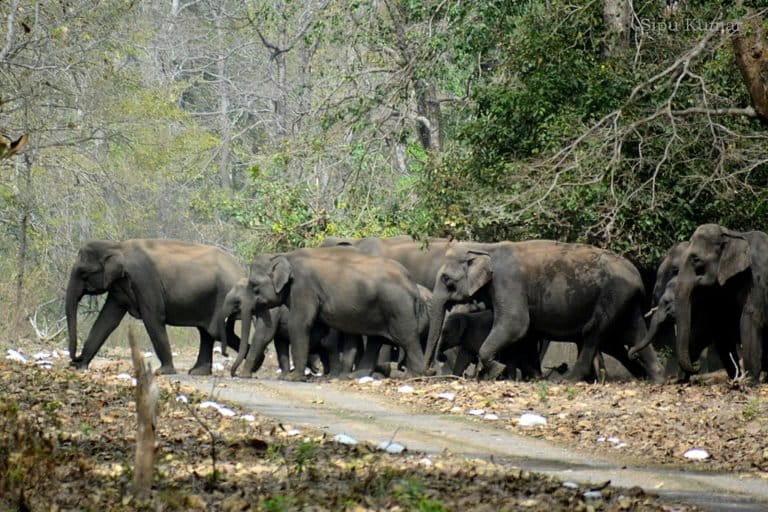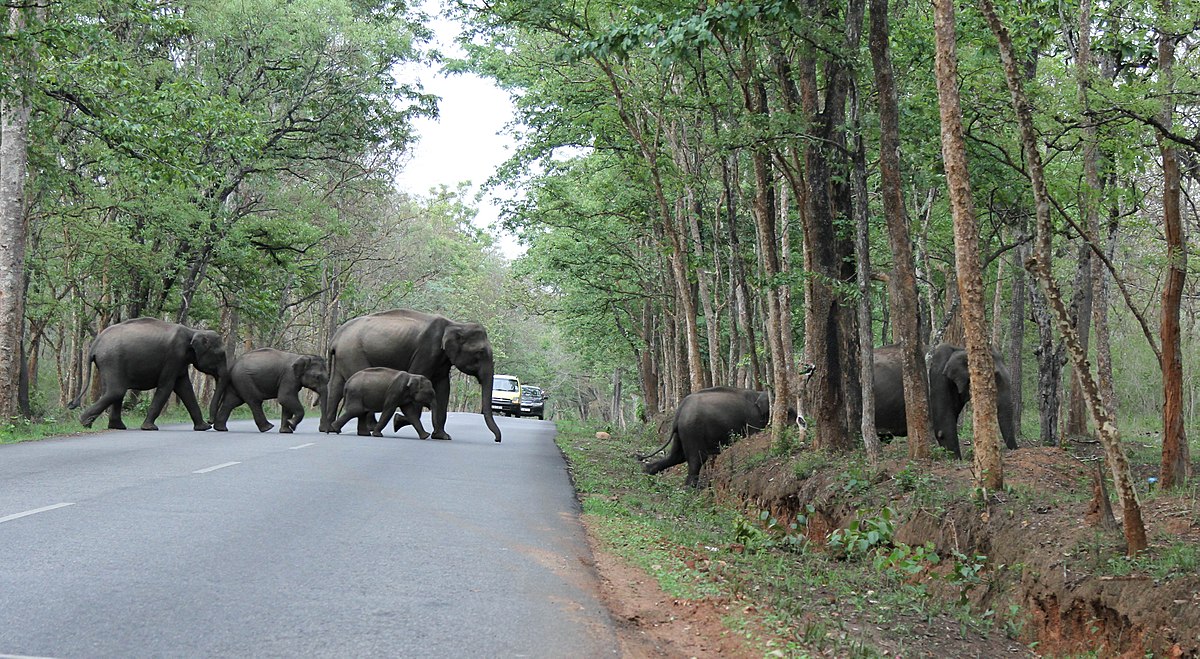- A study has found genetic differences in populations arising even over small distances separating the megaherbivores.
- While genetic clusters are expected in populations separated by large distances, such patterns over a few hundred kilometres suggest barriers to animal movement, the authors said.
- One such example is within Shivaliks, where highways, roads and encroachments drive genetic differences in elephants in Rajaji Tiger reserve and Lansdowne Division-Corbett Tiger reserves.
- The preservation of critical habitat patches and corridors that link them is indispensable for the long-term sustenance of species.
Drawing attention to the restriction of elephant movement due to development and infrastructure barriers, scientists studying genetic differences between elephant populations in the country have expressed concern over genetic differences in populations arising even over small distances separating the megaherbivores.
In India, where a large extent of elephants lie outside protected areas, elephants occur in the country’s north-western, east-central, north-eastern and southern regions with the latter two holding about 80% of the elephant population. A study conducted by Surendra Prakash Goyal and his team from Wildlife Institute of India, suggests that these four populations are genetically different from each other which is expected since they are geographically separated over more than 2000 kilometres.
However, the authors flag some genetic differences within northwest, northeast and south India populations which could be a result of limited genetic connectivity caused by rampant development and infrastructure barriers.
Researchers collected dung samples from two sites in the northwest (Uttarakhand and Uttar Pradesh), two in the northeast (West Bengal and Assam), two sites in central (Odisha) and 10 in south India (Karnataka, Kerala, Tamil Nadu). They extracted DNA from the samples and ran multiple laboratory procedures to identify genetic clusters of Asian elephants in India.
Factors such as geographic distance, habitat characteristics such as quality of forest, resource distribution such as best quality and quantity of food, availability of water and mates, and mate choice can limit gene flow, says Goyal. The presence of natural barriers such as rivers or human-made barriers such as highways, concrete walls and electric fences can also result in genetic differentiation among populations, he added. Ill-conceived development that leads to forest loss and fragmentation affects elephant movement across landscapes and hinders genetic connectivity.
Small populations in disconnected habitat patches suffer from loss of genetic diversity which could wipe out the entire populations from these small patches. Inbreeding, where related individuals mate over and over since no animals can move from or to nearby populations, increases the risk of mortality, and susceptibility to sudden environmental changes and diseases, suggested Rahul Dey, lead author of the study.

How barriers disrupt elephant movement across India
The northwest range of elephants consists of the outer Himalayas, Shivaliks and parts of Terai in Uttarakhand and Uttar Pradesh. The study found that elephants in the Shivalik elephant reserve in Uttarakhand and Katarniaghat wildlife sanctuary in Uttar Pradesh, only 120 km apart, face barriers to movement.
The differences between Shivaliks and Katarniaghat populations can be chalked up to the presence of the Torsa river. However, within Shivaliks, highways, roads and encroachments are major drivers of the genetic differences in elephants in Rajaji Tiger reserve and Lansdowne Division- Corbett Tiger reserves.
Genetic clusters are expected over large distances, says Priya Davidar, an author of the study. However, observing such patterns over a few hundred kilometres suggests the presence of barriers to animal movement, she added. In northeast India, elephants inhabit the forests and grasslands of Arunachal Pradesh, Assam, Manipur, Meghalaya, Mizoram, Nagaland and Tripura.
Researchers collected samples from Baikunthapur Forest Division (northeast West Bengal) and Jeypore reserve forest (Assam), about 650 km apart, and concluded that the genetic makeup of the two populations was different.
In south India, elephant populations are distributed over hilly tracts of the Western Ghats and parts of the Eastern Ghats in Kerala, Tamil Nadu, Karnataka and Andhra Pradesh. Northern Karnataka is the northern limit of elephant distribution in south India.
The authors found that elephants in the Nilgiri Biosphere reserve (Nagarhole National Park, Biligiriranganatha Swamy Temple Wildlife Sanctuary, Wayanad Wildlife Sanctuary, Sathyamangalam and Mudumalai Tiger Reserve, Sigur and Coimbatore Forest Division) formed one cluster. Whereas elephants in Periyar, Kalakkad Mundanthurai and Anamalai Tiger reserves together have a different genetic makeup.
These two genetic clusters (Nilgiris and Periyar/Mudanthurai/Anamalai) are separated by the Palghat Gap, a break in mountain chains of the Western Ghats which acts as a natural barrier to the connectivity of elephants and other species. However, it is alarming that there are minor differences in the geographically connected Anamali and Periyar populations. The team suggests that this loss of connectivity could be due to agriculture expansion that has occurred within the last century.
Moving forward towards Kalakkad Mundanthurai Tiger reserves, the elephants face the same fate. The Shencottah gap, a mosaic of degraded forests, linear infrastructure and human establishments hinders elephant connectivity.
Though S.P. Goyal and his team picked up some signatures of inbreeding in northeast elephant populations, the data was based on a few samples and might not be as robust.
Explore some of the natural and human-made barriers to India’s elephants
Maintenance of corridors
In the wake of splintered habitats, the preservation of critical habitat patches and strips of suitable habitats (corridors) that link them is indispensable for the long-term sustenance of species. Managing corridors at a fine scale while addressing socio-ecological aspects is crucial for animals to move and persist in a landscape.
These genetic differences at finer scales are evidence that built-up areas, infrastructure elements (roads, railway lines etc), and encroachments of corridors are impacting connectivity.
As per a report published in 2017, there are more than 100 elephant corridors in elephant landscapes. Of these, 28 are in south India, 25 in central India, 23 in northeastern India, 14 in northern West Bengal and 11 in northwestern India, yet the study reported genetic differentiation in populations over small distances, highlighting the need for re-evaluation and maintenance of corridors.
“Elephants are wide-ranging and corridors are crucial for them. But, there is not that much being done to save their corridors. Our work, for instance, on corridors in Garo Hills, shows the significant limitation to elephant movement over small distances, if there are no forests,” says Divya Vasudev, Senior Scientist, Conservation Initiatives. She was not associated with the study.
Although the presence of corridors in the landscape is indubitable, anthropogenic disturbances such as agricultural fields, tolerance by locals, mining operations, and the absence of cover and forage in the corridors, ultimately guide the ease of animal movement. Of these 100 elephant corridors, about 45% have some form of human-caused disturbance.

Some of these corridors are as trivial as 0-100 meters in Chamrajanagar-Talamalai at Punjur (Karnataka). “We need better identification of corridors, forestland that plays a critical role in connectivity either as corridors or stepping stones and ensuring no loss of forests in these areas,” Vasudev added. The existence of corridors with high human pressure may not translate into effective use by animals and hence does not ensure connectivity.
“Animal presence in the corridors connecting two habitat patches does not mean that a corridor is functional. Elephants avoid degraded habitats, densely populated areas, and linear infrastructure that hinder their movement. Measuring the exchange of gene flow between two populations connected through a corridor can help evaluate the efficiency of the corridors in maintaining connectivity,” Sandeep Sharma, German Centre for Integrative Biodiversity Research (iDiv), Halle-Jena-Leipzig, Germany, told Mongabay-India.
At present, only 12.9% of the corridors are totally under forest cover as compared to 24% as per a study conducted in 2005. About 66% of the corridors have state or national highways passing through them.
“Incorporating connectivity into the proposed amendments of the Wild Life Protection Act, such that there is legal recognition of connectivity and corridors, is crucial for maintaining corridors. In addition, securing animal movement outside corridors is also crucial which would involve stakeholders, local community members and landowners,” said Vasudev.
Though 14 proposed corridors in Odisha are still awaiting legal status, Sharma says, “After notification, corridors need to be maintained through law and order, proactive management plan, recognising eco-sensitive zones around corridors and banning any new development in the area.”
The area required for the expansion of Jolly grant airport falls within the Shivalik elephant reserve and is in proximity to Kansaro-Barkot Elephant Corridor. In addition to human activities, climate change might trigger loss of habitats compounding threats to Asian elephant populations in India.
Reeta Sharma, another author of the study emphasises that “climate change would potentially exacerbate the current threats in combination with anthropogenic activities, especially in east-central and north-west India. Agricultural expansion, infrastructure development, mining and human-elephant interactions are common problems in both areas.”
However, east-central populations require conservation prioritisation due to the greater extent of habitat fragmentation and the predicted risk of about 80% habitat loss, the authors emphasise. The population has lower genetic diversity compared to north-western and southern elephant populations, habitat is prone to frequent human-elephant interactions and is under threat by developmental activities, says the team.
As climate change affects agricultural outcomes like crop failure, the dependence of people on NTFP might increase, worsening the risk to corridors since they are accessible and under no legal protection, said Sandeep Sharma.
Map by Technology for Wildlife.
Banner image: Elephant herd crossing roads at Bandipur. Photo by Lokeshlakshmipathy/Wikimedia Commons.
